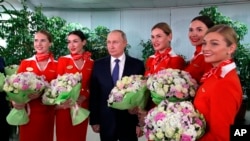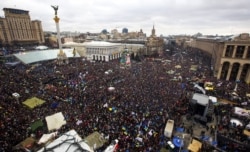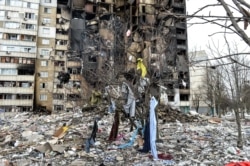On March 5, Russian President Vladimir Putin held a meeting with employees of the Russian state airline Aeroflot. The conversation quickly turned to the invasion of Ukraine, or as the Kremlin euphemistically insists on calling it, the “special military operation.”
During a Q&A that appeared to be stage-managed, Putin essentially summarized his argument for attacking Ukraine. His remarks, which went unchallenged, included multiple falsehoods and misleading statements.
Despite past Russian promises to respect Ukraine’s borders, Putin falsely argues that Ukraine is not even a real country. And he’s spuriously claimed that Ukraine’s government is fascist and full of Nazis even as his forces bombard civilians and hospitals under fierce resistance from Ukrainian military forces – and civilians who protested in the streets.
Distorting the Origins – The Maidan “Coup”
Putin retold his distorted history of the conflict with Ukraine. About Ukraine’s Maidan uprising in February 2014, he said:
“The fact is that after the state unconstitutional coup in Ukraine, which was actively supported, unfortunately, by Western countries … they said directly that they spent five billion dollars on it, they distributed hot pies on the Maidan and so on.”
But that is a false and simplistic characterization. Ukraine’s Maidan uprising was a popular revolt, not a coup. Ukraine’s pro-Russian president at the time, Viktor Yanukovych, had rejected a European-brokered agreement to revise Ukraine’s constitution. Protests had turned violent, with scores of deaths. Yanukovych ultimately resigned and fled Kyiv, then was voted out by a majority in Ukraine’s parliament who claimed he’d abandoned his office. Whether that was legally sufficient to remove Yanukovych has been a matter of dispute, but describing the events as a “coup” is a misrepresentation. Polygraph.info has previously addressed false Russian claims about Maidan.
The claim that Western countries spent $5 billion to support the “coup” simply repeats a false story line pushed by Russian state media and other pro-Kremlin sources. In fact, the $5 billion refers to the entirety of U.S. aid to Ukraine at that point since its independence from the Soviet Union in 1991, including economic development and relief programs. It includes one particularly pricey item – assisting Ukraine’s nuclear disarmament after it signed the Budapest Memorandum in 1994. Under that pact, Russia, the U.K. and the United States gave Ukraine security assurances and pledged to respect its borders if it gave up its Soviet-era nuclear stockpile.
The Phony Crimean ‘Referendum’
Next, Putin alluded to the fantasy tale that people in Crimea had rejected the Maidan “coup” and held a referendum to reunite with Russia. He said:
“Crimea, as you know, made a decision – people came to a referendum and voted – to return to the Russian Federation. Naturally, we could not but support this, especially since they were in danger from nationalists and neo-fascists. I will now say that there are full confirmations that they were right then.”
No one in Crimea was threatened by “nationalists or neo-fascists.” In fact, they were threatened by Russian soldiers wearing uniforms without insignia, who entered Crimea in March 2014, took over the parliament building, raised Russian flags and installed a pro-Kremlin leader.
The Russian occupiers organized and oversaw a so-called “referendum” in Crimea. The Organization for Security and Cooperation in Europe, which monitors elections in various countries, was prevented from working in Crimea while the vote took place. Data leaked from the Kremlin’s Human Rights Council revealed that overall voter turnout may have been as low as one-third of the Crimean population, with barely more than half voting in favor of the peninsula’s annexation by Russia.
On March 27, 2014, 100 United Nations member states supported a resolution affirming the “territorial integrity” of Ukraine and questioning the Crimean referendum’s validity. On December 7, 2020, a U.N. resolution calling on Russia to withdraw from Crimea passed with 63 votes. (The resolutions were non-binding and opposed by the Kremlin.)
Unsupported Nuclear Claims
Putin went on to make unsubstantiated claims about Ukraine seeking nuclear weapons. He said:
“Now they are talking about acquiring nuclear status, that is, acquiring nuclear weapons. We cannot ignore such things, especially since we know how the so-called West behaves towards Russia.”
Putin made a similar allegation during an address on February 21, several days before ordering the all-out invasion of Ukraine.
In fact, Ukraine began the process of nuclear disarmament in 1994. The United States has monitored the process, and neither U.S. officials nor the International Atomic Energy Agency have reported attempts by Ukraine to divert resources from peaceful atomic energy for use in nuclear weapons.
Some Ukrainian politicians have said that, given Russia’s apparent violations of the 1994 Budapest Memorandum, and given NATO’s stated unwillingness to invite Ukraine into the alliance, Ukraine’s would be justified in revising its non-nuclear status. Still, Ukraine has not done this, and there is no evidence it has taken any steps toward acquiring or producing nuclear weapons.
Bizarre Claims of Hostage Taking
In his meeting with the Aeroflot employees, Putin made a new claim – that Ukrainian defenders in Kharkiv and Sumy, both under heavy assault by Russian forces in the invasion, have been “taking foreign hostages.”
“What is happening now is also very important. Look, foreign citizens were taken hostage in Sumy, in Kharkov – more than 6,000 young people, students. They were driven to the railway station and are being held for the third day.”
Putin apparently was referring to problems with evacuating thousands of foreign students, mostly from India. Of course, if Putin was concerned about their welfare, he could have ordered his military to let them safely leave.
There no evidence that Ukrainian authorities took foreigners as “hostages.” As the BBC reported, some 20,000 of Ukraine’s 76,000 foreign students are from India. Evacuation from Ukrainian cities to the safer, western side of the country has been just as problematic and difficult for ordinary Ukrainian citizens. This is doubly so in Kharkiv, which came under assault early in the invasion and remains a major front in the war. So far, at least 12,000 Indian students have been evacuated, according to the Indian Foreign Secretary.
According to reporting by Al Jazeera, the Indian government has come under criticism for allegedly not having a plan or strategy for evacuating its citizens trapped in Ukraine. On March 1, an Indian medical student was killed by Russian shelling in Kharkiv.







